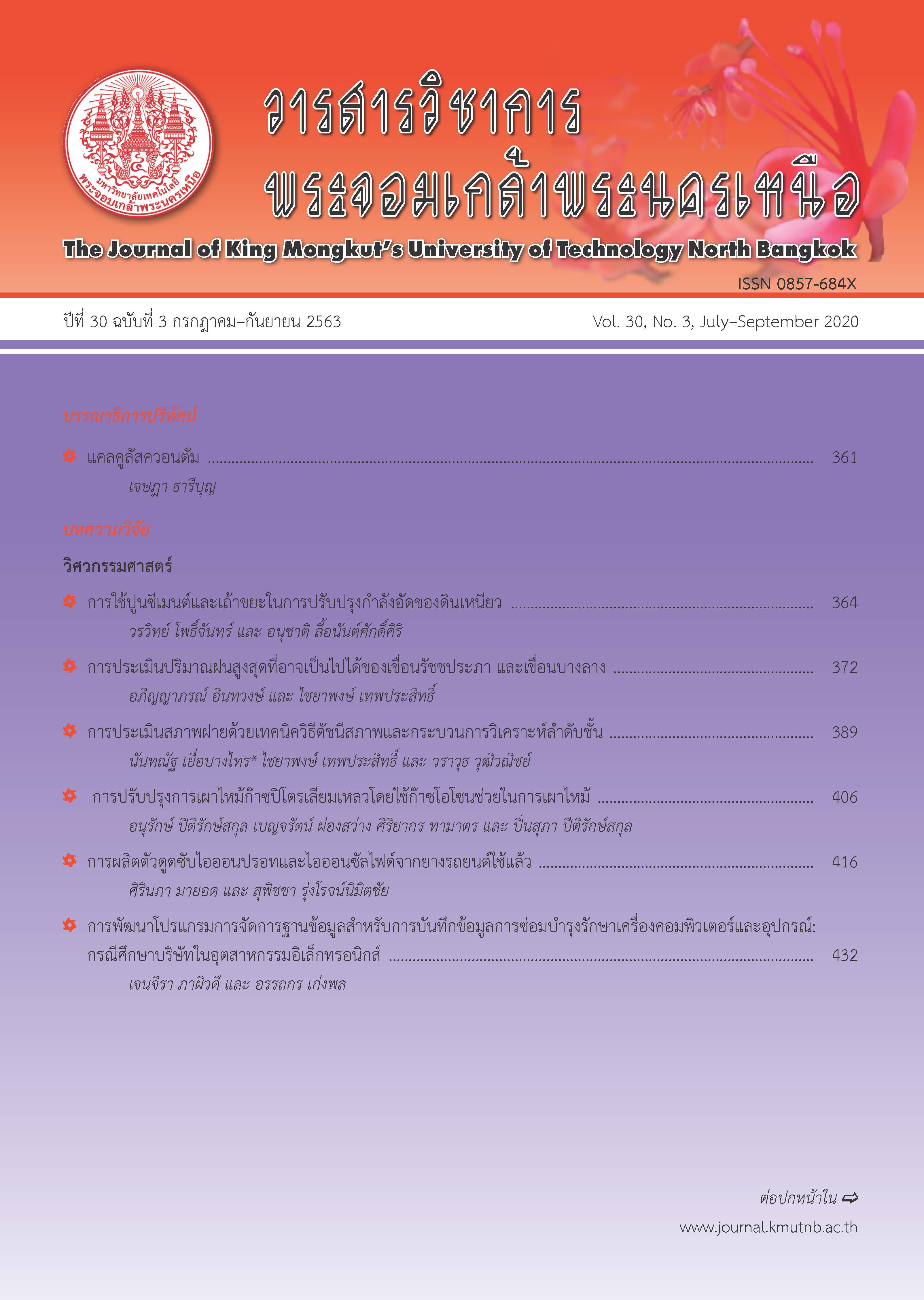รูปแบบการพัฒนาศักยภาพนักพัฒนาผลิตภัณฑ์ในอุตสาหกรรมอิเล็กทรอนิกส์
Main Article Content
บทคัดย่อ
การวิจัยครั้งนี้มีวัตถุประสงค์ 1) เพื่อศึกษาศักยภาพที่สำคัญของนักพัฒนาผลิตภัณฑ์ในกลุ่มอุตสาหกรรมอิเล็กทรอนิกส์ 2) เพื่อสร้างและพัฒนารูปแบบศักยภาพของนักพัฒนาผลิตภัณฑ์ในกลุ่มอุตสาหกรรมอิเล็กทรอนิกส์ 3) เพื่อจัดทำคู่มือแนวทางการพัฒนาศักยภาพของนักพัฒนาผลิตภัณฑ์ในกลุ่มอุตสาหกรรมอิเล็กทรอนิกส์ โดยใช้วิธีการวิจัยแบบผสมผสานการวิจัยเชิงคุณภาพ (Qualitative Research) และการวิจัยเชิงประมาณ (Quantitative Research) ประชากร ได้แก่ 1) กลุ่มผู้เชี่ยวชาญสำหรับการสัมภาษณ์เชิงลึก และกลุ่มผู้เชี่ยวชาญเพื่อประเมินคู่มือ 2) กลุ่มผู้ทรงคุณวุฒิในการประชุมสนทนากลุ่มย่อย เพื่อตรวจสอบรูปแบบ และ 3) กลุ่มตัวอย่างตอบแบบสอบถาม เครื่องมือที่ใช้ในการวิจัยเชิงคุณภาพ ได้แก่การสัมภาษณ์แบบเจาะลึก (In-depth Interview) การประชุมสนทนากลุ่มย่อย และวิเคราะห์ข้อมูลด้วยการวิเคราะห์เชิงเนื้อหา เครื่องมือที่ใช้ในการวิจัยเชิงปริมาณ ได้แก่ แบบสอบถามเชิงสำรวจ สถิตที่ใช้ในการวิเคราะห์ข้อมูล ได้แก่ ความถี่ ร้อยละ ค่าเฉลี่ย และค่าเบี่ยงเบนมาตรฐาน ผลการวิจัยพบว่า รูปแบบศักยภาพนักพัฒนาผลิตภัณฑ์ในอุตสาหกรรมอิเล็กทรอนิกส์ ประกอบไปด้วย 5 องค์ประกอบหลัก 15 องค์ประกอบรอง ได้แก่ องค์ประกอบหลักด้านความรู้ความสามารถ ประกอบด้วย 3 องค์ประกอบรองได้แก่ 1) การออกแบบผลิตภัณฑ์ 2) การเรียนรู้ในงานออกแบบ และ 3) การผลิตเชิงอุตสาหกรรม องค์ประกอบหลักด้านความคิดและการสร้างนวัตกรรม ประกอบด้วย 3 องค์ประกอบรอง ได้แก่ 1) ความคิด 2) นวัตกรรม และ 3) การคิดวิเคราะห์เชิงสัมพันธ์ องค์ประกอบหลักด้านการปรับตัวในการทำงาน ประกอบด้วย 4 องค์ประกอบรอง ได้แก่ 1) การยอมรับข้อมูล 2) การปรับรูปแบบการปฏิบัติงาน 3) มนุษย์สัมพันธ์ในการทำงาน และ 4) การปรับตัวตามสถานการณ์ องค์ประกอบหลักด้านการวางแผนออกแบบผลิตภัณฑ์ ประกอบด้วย 1 องค์ประกอบรอง ได้แก่ การวางแผนระบบงาน และองค์ประกอบหลักด้านพฤติกรรมการทำงาน ประกอบด้วย 4 องค์ประกอบรอง ได้แก่ 1) ความรับผิดชอบในงาน 2) ความรู้เท่าทันในการทำงาน 3) ความมุ่งผลสัมฤทธิ์ในงาน และ 4) ทุ่มเทการทำงานเพื่อความสำเร็จในงาน คู่มือแนวทางการพัฒนาศักยภาพนักพัฒนาผลิตภัณฑ์ในอุตสาหกรรมอิเล็กทรอนิกส์ ประกอบด้วย 2 ส่วน ส่วนที่ 1 การแนะนำคู่มือ ส่วนที่ 2 แนวทางการพัฒนาศักยภาพนักพัฒนาผลิตภัณฑ์ในอุตสาหกรรมอิเล็กทรอนิกส์ รูปแบบศักยภาพนักพัฒนาผลิตภัณฑ์ในอุตสาหกรรมอิเล็กทรอนิกส์ได้รับการลงมติเห็นชอบโดยผู้ทรงคุณวุฒิในการประชุมสนทนากลุ่มย่อยและคู่มือแนวทางการศักยภาพนักพัฒนาผลิตภัณฑ์ในอุตสาหกรรมอิเล็กทรอนิกส์ได้รับการประเมินจากผู้เชี่ยวชาญว่ามีความเหมาะสมในด้านการนำไปประยุกต์ใช้ในการพัฒนาศักยภาพนักพัฒนาผลิตภัณฑ์ในอุตสาหกรรมอิเล็กทรอนิกส์
Article Details
บทความที่ลงตีพิมพ์เป็นข้อคิดเห็นของผู้เขียนเท่านั้น
ผู้เขียนจะต้องเป็นผู้รับผิดชอบต่อผลทางกฎหมายใดๆ ที่อาจเกิดขึ้นจากบทความนั้น
เอกสารอ้างอิง
[2] P. Lumbensa. (2016, June), “Academic paper of Research and Statistic.,” Faculty of Education, Yala Rajabhat University, Yala, Thailand [Online] Available: http://edu.yru.ac.th/evaluate/attach/1465551003_%E0%B9%80%E0%B8%AD%E0%B8%81%E0%B8%AA%E0%B8%B2%E0%B8%A3%E0%B8%9B%E0%B8%A3%E0%B8%B0%E0%B8%81%E0%B8%AD%E0%B8%9A%E0%B8%81%E0%B8%B2%E0%B8%A3%E0%B8%AD%E0%B8%9A%E0%B8%A3%E0%B8%A1.pdf
[3] N. H. Ghazali, “A reliability and validity of an instrument to evaluate the school-based assessment system: A pilot study,” International Journal of Evaluation and Research in Education, vol. 5, no. 2, pp. 184–157, 2016.
[4] P. Rattanunt, “The contemporary of human resource management in the organization,” KKBS Journal, vol. 1, no. 1, pp. 21–38, 2017.
[5] T. Boonyasopon and V. Chalermjirawat, Basic Industrial Management, Bangkok: KMUTNB Textbook Publishing Center, 1994 (in Thai).
[6] T. Boonyasopon and V. Chalermjirawat, Basic Industrial Management, Bangkok: KMUTNB Textbook Publishing Center, 1994 (in Thai).
[7] A. Ratthanapant, “Potential development needs of officials of Tambon administrative organizations in Changwat Nakhon Si Thammarat,” M.S. thesis, Faculty of Social Administration, Thammasat University, 2010 (in Thai).
[8] Department of Industrial Promotion. (2016). Innovation knowledge. Department of Industrial Promotion. Bangkok, Thailand [Online]. Available: http://innovation.dip.go.th/innovation/?page_id=28
[9] B. Plengdeesakul and P. Plengdeesakul, “Developing creative products by adopting local wisdom of natural resource deployment in communities located near Chulabhorn dam A case study of mae Somsri processed fresh water fish community enterprise at Tung Lui Lai Sub-district, Kon San district, Chaiyaphum province,” Journal of Fine and Applied Arts, vol. 10, no. 2, pp. 206–230, 2018 (in Thai).
[10] P. Phibunphokasombut, Principle of Products Design. Ponlapass. Thailand [Online] Available: https://sites.google.com/a/kjwit.ac.th/ponlapass/pathor/hlak-kar-xxkbaeb-phlitphanth.
[11] M. Suacamram and U. Patkachar, “Creativity development with C - K theory: Viewpoint from expert and undergraduate students,” in Proceedings Wisdom Power for Sustainable Development, 2018, pp. 693–706.
[12] N. Chaleekrua, “Work adaptation of migrant workers: A case study of workers at the police hospital,” M.S. thesis, Department of Social Work, Faculty of Social Administration, Thammasat University, 2011 (in Thai).
[13] W. Wanchupring, “Analysis of critical success factors of product development process: Case study of automotive industry,” M.S. thesis, Department of Industrial Engineering, Faculty of Engineering, Thammasat University, 2010 (in Thai).
[14] P. S. Robbins. (2012) Management. (11th ed.) [Online] Available : https://www.academia.edu/34769562/Management_11th_edn_by_stephen_p_robbins_mary_coulter_pdf_qwerty80.
[15] A. Aei. (2012, October). Theory of Management. [Online] Available: https://adisony.blogspot.com/2012/10/henri-fayol.html?view=flipcard.
[16] W. E. Deming. (2009, June). PDCA Cycle/ Deming Cycle (-1-). Technology Promotion Association (Thailand-Japan). Bangkok, Thailand [Online] Available: http://www.tpa.or.th/writer/read_this_book_topic.php?bookID=1320&pageid=23&read=true&count=true.

